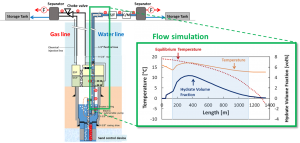
- This event has passed.
SPE APOGCE conference preview – Development of a Model and Simulation Tool to Predict Hydrate Growth in Flowlines for Gas Hydrate Production
November 17, 2020 @ 8:00 am - November 19, 2020 @ 5:00 pm

| Paper Number | : | SPE-202447-MS |
| Paper Title | : | Development of a Model and Simulation Tool to Predict Hydrate Growth in Flowlines for Gas Hydrate Production |
| Author Block | : | S. Sakurai and B.W. Norris, U. of Western Australia; B. Hoskin and J. Choi, Oilfield Technologies Pty. Ltd.; T. Nonoue, Japan Oil, Gas and Metals National Corp.; E.F. May and Z.M. Aman, U. of Western Australia |
APOGCE Conference 2020 registration:
https://www.spe-events.org/apogce2020/home
Abstract
Natural gas hydrate has attracted interest as an energy resource capable of meeting the expected growth in global energy demand. Several key issues remain to be tackled to enable commercial production, one of which is gas hydrate re-association in production lines, where significant volumes of water are co-produced with free gas. To predict this behavior, we introduce a model and simulation tool tailored towards hydrate growth in water-dominant turbulent flow.
We have produced a model to predict the growth rate of hydrate in water dominant systems, integrated into an in-house pseudo-steady-state multiphase flow simulator, named HyFAST. This is a mass transfer limited model where the growth rate is limited by the dissolution of guest gas molecules into the water-continuous phase. It considers the effect of interfacial gas-water bubble surface area, the degree of turbulence on mixing, and changes in bulk viscosity caused by hydrate particle formation. The tool is deployed to estimate the hydrate volume formed in production lines during the second offshore methane hydrate production test in Japan.
Initially, the model was validated in an experimental study against flowloop data, where, at worst, model predictions showed order of magnitude agreement with experimental growth rates; following this the model was integrated into an overall flow simulation tool used for larger scale predictions. The offshore production test was designed to use two separate lines to produce gas and water, however, some gas was entrained into the water production line, posing a risk of re-association. As such, our primary focus was on this water production line, approximately 1 km in length, rather than the gas production line, which generally remained outside the hydrate stability region. Our simulation predictions showed that the hydrate volume in the water production line was less than 5 vol%. Coupled with flowloop data which showed that blockages did not occur in similar systems up to 20 vol% hydrate, this suggests there was not a significant hydrate blockage likelihood in the offshore production test. These initial results suggest that the model may scale well from lab to field, and that such simulation tools can prove useful in discussing the consequences of hydrate re-association.
A new model and simulation tool were developed to predict the rate and extent of hydrate growth in water-dominant flow. These were used to predict hydrate formation in both flowloop experiments and actual production lines. The validation results showed that the approach may prove useful in evaluating hydrate blockage propensity in future gas hydrate production.
